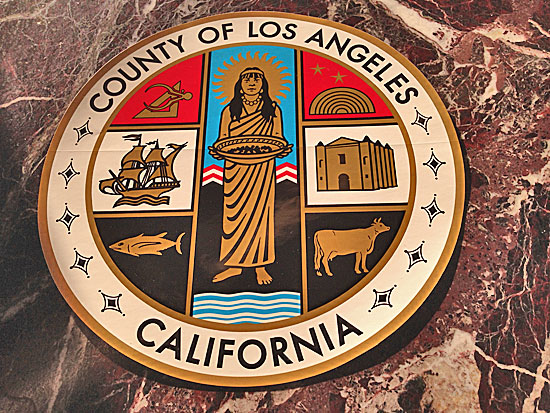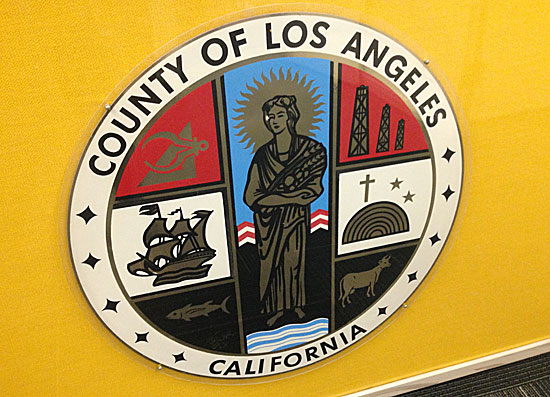
The current county seal, revised in 2004, will be changed again to include a cross atop the mission.
Reopening a long-running and divisive controversy, the Board of Supervisors this week voted to once again place a cross on the Los Angeles County seal.
The action came nearly a decade after the board agreed to remove the Christian symbol under threat of a legal challenge by the American Civil Liberties Union. The county spent hundreds of thousands of dollars after that 2004 decision to replace the seal with a redesigned version that now appears throughout its facilities and on items ranging from business cards and badges to uniforms and vehicles.
The impetus for the board’s about-face this week was a motion by Supervisors Michael D. Antonovich and Don Knabe, who argued that the current seal’s depiction of the San Gabriel Mission without a cross is “artistically and architecturally inaccurate.” Although the cross was removed from the mission during retrofitting following the Whittier Narrows earthquake, their motion said, it has since been restored to the structure and the county seal should reflect that.
Supervisor Mark Ridley-Thomas joined Antonovich and Knabe in voting to bring back the cross. Supervisors Gloria Molina and Zev Yaroslavsky voted against the measure.
Although the motion made no mention of religion, Yaroslavsky said the cross is the principal symbol of one particular faith, and noted that there is extensive legal precedent barring its incorporation into the seal on Constitutional grounds.
“The court cases have made it very clear that the use of a symbol, the principal symbol of any religion on a government seal, is unconstitutional,” Yaroslavsky said.
“And this is not just about history,” he added. “It’s about the cross. To say anything different would be really somewhat disingenuous…There are a hundred ways we could depict history. But the one that’s been chosen here is the cross.”
The county seal currently in use replaced a 1957 version designed by the late Supervisor Kenneth Hahn and drawn by the artist Millard Sheets. Hahn said at the time that the seal was intended to depict “the cultural and educational and the religious life of this county.” Featured on the seal, in addition to the cross, were images including the Hollywood Bowl, a Spanish galleon, a tuna, a prize-winning Guernsey cow named Pearlette, several oil derricks and the goddess Pomona carrying fruit. The redesigned seal eliminated the cross, the derricks and the goddess but added an image of a mission (without a cross) and a Native American woman.
The 2004 decision to drop the cross prompted an uproar, with nearly 1,000 people gathering outside the Hall of Administration on the day of the Board of Supervisors’ vote, some with signs calling the ACLU the “Annihilation of Christian Liberties Union.” Hahn’s children, then-Mayor James Hahn and then-Councilwoman Janice Hahn, argued in favor of keeping the symbol on the county seal.
Yaroslavsky, however, said at the time he was willing to make an unpopular decision if it was the right thing to do: “The First Amendment is not a popularity contest.”
At Tuesday’s meeting, he once again argued against including a religious symbol on a government seal, but this time was on the losing end of the vote. Before the board’s 3-2 decision, Yaroslavsky predicted the county would face, and lose, a legal challenge—particularly since it would be restoring a symbol it had removed after questions were raised about its constitutionality.
That point was echoed by Peter J. Eliasberg, legal director of the ACLU of Southern California, who said reincorporating the cross into the county seal would violate both state and U.S. constitutions. He also said that the separation of church and state has helped to strengthen religious activity in the United States, not to diminish it.
“The ACLU strongly believes that religion has flourished in this country, perhaps more than any other, and religious pluralism has flourished because the government does not favor or denigrate any particular religion,” he said. “Adding a sectarian religious symbol to the county seal, the preeminent symbol of one particular religion, runs against that grain.”
After the meeting, Eliasberg would not say whether his organization plans to file a lawsuit.
While Eliasberg spoke against the motion, several others supported it, including a resident of Altadena who said: “There’s nothing unconstitutional about having an historical reference to the role of religion in the formation of the nation…None of this has really anything to do with the Board of Supervisors or anyone else promoting religion. We’re just accurately depicting our cultural heritage in history.”
Posted 1/8/14







